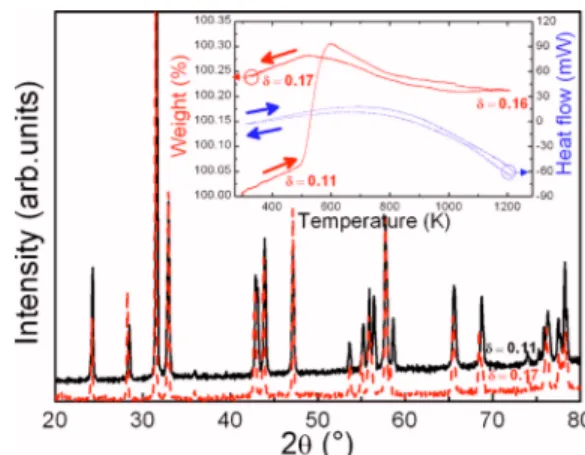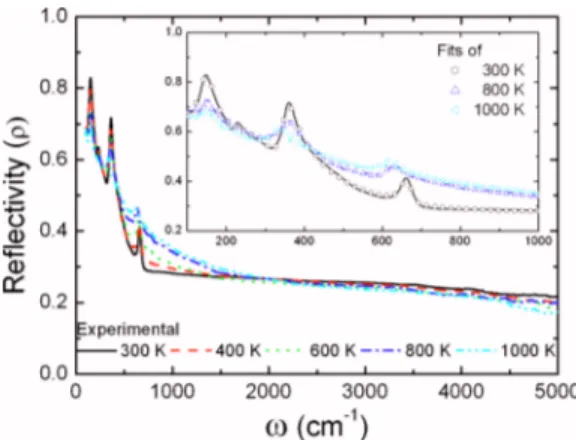O
pen
A
rchive
T
OULOUSE
A
rchive
O
uverte (
OATAO
)
OATAO is an open access repository that collects the work of Toulouse researchers and
makes it freely available over the web where possible.
This is an author-deposited version published in :
http://oatao.univ-toulouse.fr/
Eprints ID : 4738
To link to this article : DOI :10.1063/1.3511344
URL : http://dx.doi.org/10.1063/1.3511344
To cite this version : Ta, M.T. and Rolland, J.Y. and Echegut,
P. and Rousseau, Benoit and Zaghrioui, M. and Giovannelli,
F. and Gomart, Hector and Lenormand, Pascal and Ansart,
Florence ( 2010) Prediction of thermal radiative properties
(300–1000 K) of La2NiO4+δ ceramics. Applied Physics Letters,
vol. 97 (n° 18). 181917-181917-3 . ISSN 0003-6951
Any correspondance concerning this service should be sent to the repository
administrator: staff-oatao@inp-toulouse.fr
.Prediction of thermal radiative properties
„300–1000 K… of La
2NiO
4+␦ceramics
M. T. Ta,1J. Y. Rolland,1P. Echegut,1B. Rousseau,1,a兲 M. Zaghrioui,2F. Giovannelli,2 H. Gomart,3P. Lenormand,4and F. Ansart4
1
CEMHTI CNRS, UPR 3079, 1D avenue de la Recherche Scientifique, 45071 Orléans, France
2
LEMA CNRS, UMR 6157, IUT de Blois, 3 place Jean Jaurès, 41029 Blois, France
3
EM2C CNRS, UPR 288, Ecole Centrale Paris, Grande Voie des Vignes, 92295 Châtenay-Malabry, France
4
CIRIMAT CNRS, UMR 5085, Université Paul Sabatier, 118 Route de Narbonne, 31062 Toulouse, France
A multiscale numerical model is developed to predict the thermal radiative properties 共TRP兲 of rough La2NiO4+␦ coatings. The model integrates intrinsic and extrinsic contributions related to the
chemical composition and the texture, respectively. High-temperature infrared reflectivity and thermogravimetric measurements on a La2NiO4+␦single crystal make it possible to understand the
role of the excess oxygen in the intrinsic TRP. We show that dense ceramics with thicknesses higher than 4 m are optically thick, and that one can adjust the surface roughness parameters to predict their TRP.
Solid oxide fuel cells共SOFCs兲 with a planar configura-tion are of great interest as efficient and ecologically clean energy conversion systems. At the highest operating tem-peratures共T⬃1000 K兲, thermal gradients inside the cell and at the contacts lead to mechanical failures that limit the use-fulness of the devices.
However, for engineers aiming to suppress this un-wanted behavior, only a few thermophysical parameters 共phonon thermal conductivity, radiative conductivity兲 that are required to predict the temperature field at the operating temperature are available in the literature. Moreover, since the ceramics used in SOFCs are often heterogeneous, the knowledge of their thermophysical properties is not straight-forward. In particular, the thermal radiative properties共TRP兲 of SOFCs ceramic are unknown and, in more general view-point, few attempts have been made to establish a firm con-nection between the textural parameters and TRP.1To solve this issue, we develop a numerical methodology integrating material parameters 共chemical and textural兲 from the nano-meter scale to the millinano-meter scale.
La2NiO4+␦ is used in SOFCs due to its favorable ionic
and electronic properties.2Thus, in this compound, the oxy-gen over-stoichiometry 共␦兲 plays a crucial role in its struc-tural properties,3 since it relaxes the constraints of the dis-torted undoped compound and creates holes in the NiO2
planes, inducing highly anisotropic behavior.4Understanding the role of ␦ as a function of temperature, is therefore, nec-essary to predict the intrinsic TRP, as has been shown by some of the authors for the isostructural Pr2NiO4+␦ system.5
In this paper, we report high-temperature infrared reflec-tivity measurements on a La2NiO4+␦共T兲single crystal and cor-relate them with the temperature dependence of ␦. We then use a numerical tool based on a Monte Carlo ray-tracing 共MCRT兲 code6 aiming to predict the contribution played by the surface roughness of model rough dense ceramics of La2NiO4+␦.
The crystals were grown in air by the floating zone tech-nique in an image furnace 共Cyberstar兲. The feed rod was sintered in air at 1300 ° C for 12 h and prepared from La2NiO4.18 powders according to the Pecchini method.7The chemical composition was checked by Inductively Coupled Plasma spectrometry for cationic composition, and thermo-gravimetric analysis—differential scanning calorimetry 共TGA-DSC兲 and iodometric titration for oxygen content. The crystallinity and the structure of the crystal were checked by Laue and powder x-ray diffraction共XRD兲 on a single crystal and a ground crystal, respectively. Infrared reflectivity spec-tra共共兲兲 were measured over the range 300–1000 K with a Fourier Transform Infrared共Bruker 113v兲 spectrometer with the electric field lying in the ab plane and along the c axis.8,9 Figure1presents the XRD pattern of the ground crystal. Rietveld analysis with the space group I4/mmm shows that the sample is single-phase and consistent with the tetragonal K2NiF4 type structure. Chemical analyses lead to a
La2NiO4.11 composition for the single crystal. In order to determine the evolution of␦, TGA-DSC measurements were performed on the ground crystal under the same temperature conditions as in the spectrometer 共inset in Fig. 1兲. We
ob-a兲Electronic mail: benoit.rousseau@cnrs-orleans.fr.
FIG. 1. 共Color online兲 Room temperature XRD patterns of La2NiO4+␦ crushed single crystal共␦= 0.11 and 0.17兲 and Inset: TGA-DSC measure-ments under air for La2NiO4+␦crushed single crystal.
serve an abrupt weight gain at about 320 K and at above 620 K, the sample begins to lose the oxygen and continues losing it up to 1200 K. The weight gain with heating shows that ␦ increases共␦after= 0.17 compared to␦before= 0.11兲, and that re-oxidation occurs. Note that at 1000 K,␦⬃0.16, so the elec-tronic concentration remains sufficiently high to generate ef-ficient optical absorption.5Moreover, no peak is observed in the DSC curve, showing that there is no decomposition or structural transition during the temperature cycle. This was confirmed by XRD on the final product as shown in Fig.1. The reflectivity spectra 共兲 in the ab plane, 共Fig. 2兲 exhibits two remarkable microscopic mechanisms: 共i兲 infrared-active phonons in which mobile polarons are superimposed8 共wavenumber ⬍1000 cm−1兲, and 共ii兲
trapped polarons resulting from the coupling between the charge carriers induced by the chemical doping and the lat-tice 共⬎1000 cm−1兲. To obtain the complex refractive
in-dex of the La2NiO4 single crystal, we model 共兲 with the double-damping Drude 共DDD兲 dielectric function 共˜兲.9–11 This function takes into account the contributions of the phonons and of the trapped carriers and an extended Drude term is added to describe the response of the mobile carriers. The advantages and limitation of this model have been in-tensively discussed with respect to other models in the literature.5,11Some of the modeled spectra are shown in Fig. 2 and the fitting procedure is consistent with previous works.10,12 Due to the re-oxidation, the level and shape of each 共兲 are not greatly affected by the temperature in-crease. This suggests that optical mechanisms involving the trapped and mobile carriers are active at high temperatures, consistent with the TGA results共inset of Fig.1兲. In fact the study of the optical behavior of the single crystal make it possible to model the optical response imposed by the carri-ers in the ab plane. Then, the good agreement 共inset in Fig. 2兲 between the experimental and fitted spectra ensures that the optical parameters are reliable.
The index of refraction共n兲 and extinction coefficient 共k兲 can be derived as n = Re共冑˜兲 and k=Im共冑˜兲, respectively. With these values, we can calculate the TRP of model dense and rough ceramics composed of randomly oriented submi-cron grains, by averaging13the complex dielectric functions in the ab plane and along the c axis. n and k can then be introduced into a homemadeMCRTcode6 to obtain the TRP.
By considering that a ceramic is opaque if Kd⬎1, where
d is the thickness of the layer and K = 4kis the absorption coefficient, we checked that a dense ceramic of La2NiO4+␦is
opaque for a minimum thickness of 3.67 m over the entire measured temperature range 共3.67 m, 2.77 m, and 2.35 m for 300 K, 800 K, and 1000 K, respectively兲.
Since for a real coating the surface is often rough, we integrate this contribution in our model. To quantify this effect14on the TRP, we have made calculations for a Gauss-ian rough surface 共GRS兲 with a roughness slope 共␣rms =
冑
2共rms/兲兲 varying from 0 to 2. MCRTcode6calculationswere performed with 104photon rays for three-dimensional surfaces with different slopes. The optical indices 共n,k兲 at two frequencies and three temperatures共400 and 5000 cm−1
at 300, 800, and 1000 K兲 were used to calculate the variation in normal spectral emissivity with surface roughness共Fig.3兲. The shapes of the three curves are very similar to those ob-tained by other authors15for metallic rough coatings. In par-ticular, the results show that the emissivity increases with roughness when the slope of the GRS is greater than 0.28. Note that for a real cathodic layer composed of La2NiO4+␦,6
␣rmsis smaller than 0.28. It confirms our prediction that in
this case the emissivity is not influenced by the roughness. On the other hand, for a GRS of Pr2NiO4+␦. 共Pr2NiO4+␦. is
isostructural to La2NiO4+␦兲 with higher slope 共␣rms= 0.64兲, a previous work has shown experiments verify a similar theo-retical curve.16
In summary, the thermal radiative properties of La2NiO4+␦ single crystal were investigated to study their
temperature evolution at different values of the␦. By using a DDD model, the complex index of refraction was extracted from the reflectivity spectra acquired by infrared spectros-copy at high temperature. These results were introduced into a multiscale numerical model aiming to predict the TRP of cathodic layers on SOFCs as a function of surface roughness. This work shows how we can modify the TRP of an opaque rough coating by adjusting its chemical and textural param-eters.
We thank D. De Sousa Meneses, A. Blin, D. L. Price, and L. del Campo for helpful discussions. This work was funded by “Région Centre”共FEDER-EOMAT兲.
FIG. 2. 共Color online兲 Measured infrared reflectivity of a La2NiO4.11single crystal for the electric field lying in the ab plane at various temperatures. The inset shows fits共symbols兲 to the experimental reflectivity spectra 共solid lines兲 at 300, 800, and 1000 K in the spectral range up to 1000 cm−1.
FIG. 3. 共Color online兲 Calculated spectral emissivity of a La2NiO4+␦single crystal as a function of surface roughness characterized by the standard deviation of the slopes␣rmsat two frequencies共兲 and three temperatures. Fixing the rms height-rmsat 7.68 m, and varying the correlation length-. The length of the samples is 511.5 m; with a resolution of 0.5 m. The standard deviation 共0.04%兲 gives a good precision with a fast simulation speed.
1D. W. Lee and W. D. Kingery,J. Am. Ceram. Soc. 43, 594共1960兲. 2E. Boehm, J.-M. Bassat, P. Dordor, F. Mauvy, J.-C. Grenier, and P.
Stevens,Solid State Ionics 176, 2717共2005兲.
3D. E. Rice and D. J. Buttrey,J. Solid State Chem. 105, 197共1993兲. 4J. M. Bassat, P. Odier, A. Villesuzanne, C. Marin, and M. Pouchard,Solid
State Ionics 167, 341共2004兲.
5B. Rousseau, D. De Sousa Meneses, A. Blin, M. Chabin, P. Echegut, P. Odier, and F. Gervais,Phys. Rev. B 72, 104114共2005兲.
6B. Rousseau, H. Gomart, D. Zanghi, D. Bernard, and M. Stampanoni,J.
Mater. Res. 25, 1890共2010兲.
7M. L. Fontaine, C. Laberty-Robert, M. Verelst, J. Pielaszeck, P. Lenor-mand, F. Ansart, and P. Tailhades,Mater. Res. Bull. 41, 1747共2006兲.
8F. Gervais, High-Temperature Infrared Reflectivity Spectroscopy by
Scan-ning Interferometry共Academic, New York, 1983兲, Vol. 8, p. 7.
9B. Rousseau, J. M. Bassat, A. Blin, M. S. de Oliveira, P. Odier, C. Marin, and P. Simon,Solid State Sci. 6, 1131共2004兲.
10N. Poirot-Reveau, P. Odier, P. Simon, and F. Gervais,Phys. Rev. B 65, 094503共2002兲.
11F. Gervais,Mater. Sci. Eng., R. 39, 29共2002兲.
12X.-X. Bi, P. C. Eklund, and J. M. Honig,Phys. Rev. B 48, 3470共1993兲. 13T. G. Mayerhöfer,J. Opt. A, Pure Appl. Opt. 4, 540共2002兲.
14J.-J. Wu,Tribol. Int. 33, 47共2000兲.
15D. Bergström, J. Powell, and A. F. H. Kaplan,J. Appl. Phys.103, 103515 共2008兲.
16B. Rousseau, M. Chabin, P. Echegut, A. Sin, F. Weiss, and P. Odier,Appl.

